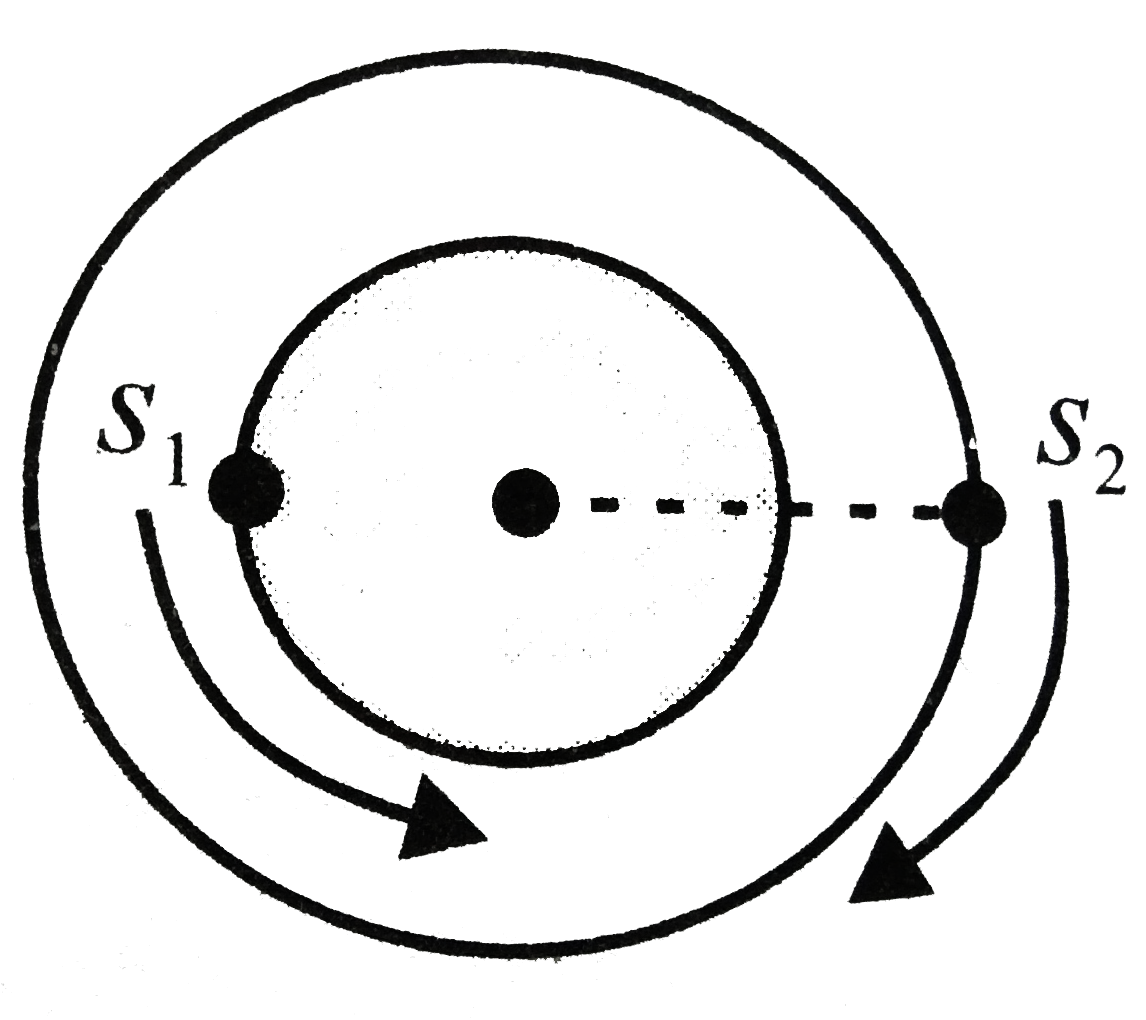Two satellites S1 and S2 are revolving around the earth in coplanar concentric orbits in the opposite sense. At t=0, the position of satellites are shown in the diagram. The periods of S1 and S2 are 4h and 24h, respectively. The radius of orbit of S1 is 1.28×104km. For this situation, mark the correct statement (s).

The angular velocity of S2 as observed by S1 at t=12h is 0.468πrads−1
The two satellites are closet to each other for the first tme at t=12h and then after every 24h they are closet to each other.
The orbital velocity of S1 is 0.64π×104km.
The velocity of S1 relative to S2 is continuously changing in magnitude and direction both.
The correct Answer is:A, B, C, D
From Kepler's law, T2∝R3
So, T1T2=(R1R2)32
R2=(T2T1)23×R1=(246)23×1.28×104km
=3.22×104km
Orbital velocity of S1 is
v1=2πR1T1=2π×1.28×1044
=0.64π×104km
Orbital velocity is S2 is
v2=2πR2T2=2π×1.28×1044
=0.64π×104km
At t=12h the two satellites are closet to each other and after every 24h they come at the same position relative to each other. It is clear that direction of v2 w.r.t v1 is changing continously in both magnitude and direction.
Angular velocity of S2 w.r.t S1 at t=12h is
ω=(v1+v2)/(R2−R1)=0.468πrad/s−1
Topper's Solved these Questions
- GRAVITATIONBOOK - CENGAGE PHYSICS ENGLISHCHAPTER - GRAVITATIONEXERCISE - Assertion- Reasoning
13 Videos
- GRAVITATIONBOOK - CENGAGE PHYSICS ENGLISHCHAPTER - GRAVITATIONEXERCISE - Linked Comprehension
23 Videos
- GRAVITATIONBOOK - CENGAGE PHYSICS ENGLISHCHAPTER - GRAVITATIONEXERCISE - Single Correct
122 Videos
- FLUID MECHANICSBOOK - CENGAGE PHYSICS ENGLISHCHAPTER - FLUID MECHANICSEXERCISE - INTEGER_TYPE
1 Videos
- KINEMATICS-1BOOK - CENGAGE PHYSICS ENGLISHCHAPTER - KINEMATICS-1EXERCISE - Integer
9 Videos
Similar Questions
Two satellites S1 and S2 are revolving round a planet in coplanar and concentric circular orbit of radii R1 and R2 in te same direction respectively. Their respective periods of revolution are 1 hr and 8 hr. the radius of the orbit of satellite S1 is equal to 104km. Find the relative speed in kmph when they are closest.
View SolutionIf a satellite of mass 400 kg revolves around the earth in an orbit with speed 200 m/s then its potential energy is
View Solution
Knowledge Check
Two satellites S1 and S2 revolve around a planet in coplanar circular orbits in the same sense their periods of revolution are 1 hour and 8hours respectively the radius of the orbit of S1 is 104 km when S1 is closest to S2 the angular speed of S2 as observed by an astronaut in S1 is :
Aπ×104B−π×104Cπ×105Dπ×105
Two satellites S1 and S2 revolve around the earth at distances 3R and 6R from the centre of the earth. Find the ratio of their (a) linear speeds and (b) angular speeds.
View SolutionTwo satellites S1 and S2 revolve round a planet in coplaner circular orbit in the same sense. Their period of revolution are 1 hour and 8 hour respectively. The radius of the orbit of S1 is 104km. When S2 is closest to S1, find
(a) The speed of S2 relative to S1,
(b) The angular speed of S2 actually observed by an astronaut is S1
View SolutionTwo satellities s1 a & s2 of equal masses revolves in the same sense around a heavy planet in coplaner circular orbit of radii R & 4R
View SolutionTwo satellite S1andS2 revolve round a planet in coplanar circular orbits in the same sense. Their periods of revolutions are 1 h nd 8 h respectively. The radius of the orbit of S1 is 104km. When S2 is closet to S1., find (a). The speed of S2 relative to S1 and (b). the angular speed of S2 as observed by an astronaut in S1.
View SolutionTwo satellites A and B revolve around a plant in two coplanar circular orbits in the same sense with radii 104km and 2×104km respectively. Time period of A is 28 hours. What is time period of another satellite?
View SolutionTwo capacitors C1 and C2 are charged to same potential V, but with opposite polarity as shown in the figure. The switches S1 and S2 are then closed

View SolutionTwo satellites of earth S1 and S2 are moving in the same orbit. The mass of S1 is four times the mass of S2. Which one of the following statements is true?
View Solution
